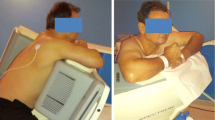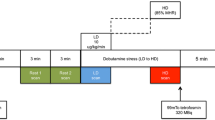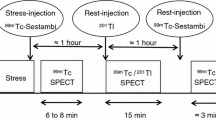Abstract
Purpose
Appropriate use of SPECT imaging is regulated by evidence-based guidelines and appropriateness criteria in an effort to limit the burden of radiation administered to patients. We aimed at establishing whether the use of a low dose for stress–rest single-day nuclear myocardial perfusion imaging on an ultrafast (UF) cardiac gamma camera using cadmium-zinc-telluride solid-state detectors could be used routinely with the same accuracy obtained with standard doses and conventional cameras.
Methods
To this purpose, 137 consecutive patients (mean age 61 ± 8 years) with known or suspected coronary artery disease (CAD) were enrolled. They underwent single-day low-dose stress–rest myocardial perfusion imaging using UF SPECT and invasive coronary angiography. Patients underwent the first scan with a 7-min acquisition time 10 min after the end of the stress protocol (dose range 185 to 222 MBq of 99mTc-tetrofosmin). The rest scan (dose range 370 to 444 MBq of 99mTc-tetrofosmin) was acquired with a 6-min acquisition time. The mean summed stress scores (SSS) and mean summed rest scores (SRS) were obtained semiquantitatively.
Results
Coronary angiograms showed significant epicardial CAD in 83% of patients. Mean SSS and SRS were 10 ± 5 and 3 ± 3, respectively. Overall the area under the ROC curve for the SSS values was 0.904, while the areas under the ROC curves for each vascular territory were 0.982 for the left anterior descending artery, 0.931 for the left circumflex artery and 0.889 for the right coronary artery.
Conclusion
This pilot study demonstrated the feasibility of a low-dose single-day stress–rest fasting protocol performed using UF SPECT, with good sensitivity and specificity in detecting CAD at low patient exposure, opening new perspectives in the use of myocardial perfusion in ischaemic patients.





Similar content being viewed by others
References
Shaw LJ, Iskandrian AE. Prognostic value of gated myocardial perfusion SPECT. J Nucl Cardiol. 2004;11:171–85.
Einstein AJ, Moser KW, Thompson RC, Cerqueira MD, Henzlova MJ. Radiation dose to patients from cardiac diagnostic imaging. Circulation. 2007;116:1290–305.
Einstein AJ, Henzlova MJ, Rajagopalan S. Estimating risk of cancer associated with radiation exposure from 64-slice computed tomography coronary angiography. JAMA. 2007;298:317–23.
Borges-Neto S, Paganelli RA, Shaw LK, Honeycutt E, Shwartz SC, Adams GL, et al. Clinical results of a novel wide beam reconstruction method for shortening time of Tc-99m cardiac SPECT perfusion studies. J Nucl Cardiol. 2007;14:555–65.
Sharir T, Ben-Haim S, Merzon K, Prochorov V, Dickman D, Ben-Haim S, et al. High-speed myocardial perfusion imaging: initial clinical comparison with conventional dual detector Anger camera imaging. JACC Cardiovasc Imaging. 2008;1:156–63.
Berman DS, Kang X, Tamarappoo B, Wolak A, Hayes SW, Nakazato R, et al. Stress thallium-201/rest technetium-99m sequential dual isotope high-speed myocardial perfusion imaging. JACC Cardiovasc Imaging. 2009;2:273–82.
Volokh L, Lahat C, Binyamin E, Blevis I. Myocardial perfusion imaging with an ultra-fast cardiac SPECT camera: a phantom study. IEEE Nucl Sci Symp Conf Rec. 2008:4636–4639
Esteves FP, Raggi P, Folks RD, Keidar Z, Askew JW, Rispler S, et al. Novel solid-state-detector dedicated cardiac camera for fast myocardial perfusion imaging: multicenter comparison with standard dual detector cameras. J Nucl Cardiol. 2009;16:927–34.
Herzog BA, Buechel RR, Katz R, Brueckner M, Husmann L, Burger IA, et al. Nuclear myocardial perfusion imaging with a cadmium-zinc-telluride detector technique: optimized protocol for scan time reduction. J Nucl Med. 2010;51:46–51.
Buechel RR, Herzog BA, Husmann L, Burger IA, Pazehenkottil AP, Treyer V, et al. Ultrafast nuclear myocardial perfusion imaging on a new gamma camera with semiconductor detector technique: first clinical validation. Eur J Nucl Med Mol Imaging. 2010;37:773–8.
Duvall WL, Croft LB, Godiwala T, Ginsberg E, George T, Henzlova MJ. Reduced isotope dose with rapid SPECT MPI imaging: initial experience with a CZT camera. J Nucl Cardiol. 2010;17:1009–14.
Duvall WL, Croft LB, Ginsberg ES, Einstein AJ, Guma KA, George T, Henzlova MJ. Reduced isotope dose and imaging time with a high efficiency CZT SPECT camera. J Nucl Cardiol. 2011, in press. doi:10.1007/s12350-011-9379-7.
DePuey EG, Bommireddipalli S, Clark J, Leykekhman A, Thompson LB, Friedman M. A comparison of the image quality of full-time myocardial perfusion SPECT vs wide beam reconstruction half-time and half-dose SPECT. J Nucl Cardiol. 2011;18:273–80.
Gibbons RJ, Balady GJ, Bricker JT, Chaitman BR, Fletcher GF, Froelicher VF, et al. ACC/AHA 2002 guideline update for exercise testing: summary article: a report of the American College of Cardiology/American Heart Association Task Force on Practice Guidelines (Committee to Update the 1997 Exercise Testing Guidelines). Circulation. 2002;106:1883–92.
Farkash G, Kenig T, Grabnic M, Yuzefovich B, Sachs J, Bocher M. Volumetric quantitation of left ventricular perfusion and function from myocardial perfusion SPECT: Validation of a new algorithm [abstract]. J Nucl Cardiol. 2006;13(suppl):s5–6.
Gimelli A, Bottai M, Giorgetti A, Genovesi D, Kusch A, Ripoli A, et al. Comparison between ultrafast and standard SPECT in patients with coronary artery disease: a pilot study. Circ Cardiovasc Imaging. 2011;4:51–8.
Giorgetti A, Rossi M, Stanislao M, Valle G, Bertolaccini P, Maneschi A, et al. Myoview imaging optimization (MIO) multicenter study: feasibility and diagnostic accuracy of a new early and fast gated SPECT imaging protocol. J Nucl Med. 2007;48:1670–5.
Cerqueira MD, Weissman NJ, Dilsizian V, Jacobs AK, Kaul S, Laskey WK, et al. Standardized myocardial segmentation and nomenclature for tomographic imaging of the heart: a statement for healthcare professionals from the cardiac imaging committee of the council on clinical cardiology of the American Heart Association. Circulation. 2002;105:539–42.
Sharir T, Berman DS, Waechter PB, Areeda J, Kavanagh PB, Gerlach J, et al. Quantitative analysis of regional motion and thickening by gated myocardial perfusion SPECT: normal heterogeneity and criteria for abnormality. J Nucl Med. 2001;42:1630–8.
Berry C, L’Allier PL, Gregoire J, Lesperance J, Levesque S, Ibrahim R, et al. Comparison of intravascular ultrasound and quantitative coronary angiography for the assessment of coronary artery disease progression. Circulation. 2007;115:1851–7.
Highley B, Smith FW, Smith T. Technetium 99m-1,2-bis(bis(2-ethoxyethyl)phosphino)ethane: human biodistribution, dosimetry and safety of a new myocardial perfusion agent. J Nucl Med. 1993;34:30–8.
Stabin MG, Sparks RB, Crowe E. OLINDA/EXM: the second-generation personal computer software for internal dose assessment in nuclear medicine. J Nucl Med. 2005;46:1023–7.
Fraker Jr TD, Fihn SD, Gibbons RJ, Abrams J, Chatterjee K, Daley J, et al. 2007 chronic angina focused update of the ACC/AHA 2002 Guidelines for the management of patients with chronic stable angina: a report of the American College of Cardiology/American Heart Association Task Force on Practice Guidelines Writing Group to develop the focused update of the 2002 Guidelines for the management of patients with chronic stable angina. Circulation. 2007;116:2762–72.
Fox K, Garcia MA, Ardissino D, Buszman P, Camici PG, Crea F, et al. Guidelines on the management of stable angina pectoris: executive summary: The Task Force on the Management of Stable Angina Pectoris of the European Society of Cardiology. Eur Heart J. 2006;27:1341–81.
Gimelli A, Rossi G, Landi P, Marzullo P, Iervasi G, L'abbate A, et al. Stress-rest myocardial perfusion abnormalities by gated SPECT: still the best predictor of cardiac events in stable ischemic heart disease. J Nucl Med. 2009;50(4):546–53.
Acknowledgments
We are grateful to Claudio Marcassa, MD, and Ornella Rimoldi, MD, for their excellent help in reviewing the paper.
Conflicts of interest
None.
Author information
Authors and Affiliations
Corresponding author
Rights and permissions
About this article
Cite this article
Gimelli, A., Bottai, M., Genovesi, D. et al. High diagnostic accuracy of low-dose gated-SPECT with solid-state ultrafast detectors: preliminary clinical results. Eur J Nucl Med Mol Imaging 39, 83–90 (2012). https://doi.org/10.1007/s00259-011-1918-6
Received:
Accepted:
Published:
Issue Date:
DOI: https://doi.org/10.1007/s00259-011-1918-6




